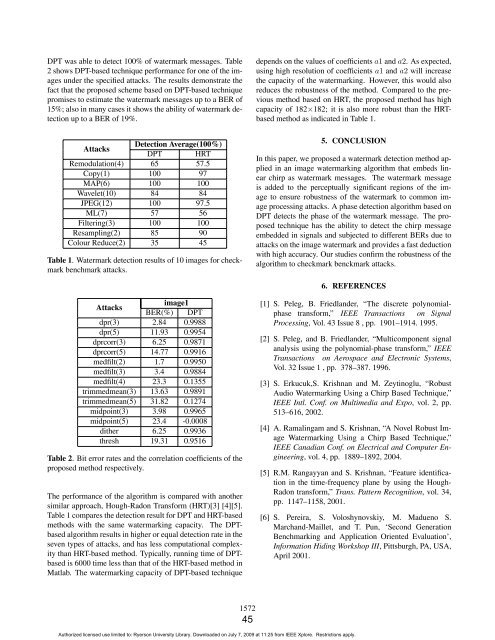Signal Analysis Research (SAR) Group - RNet - Ryerson University
Signal Analysis Research (SAR) Group - RNet - Ryerson University
Signal Analysis Research (SAR) Group - RNet - Ryerson University
Create successful ePaper yourself
Turn your PDF publications into a flip-book with our unique Google optimized e-Paper software.
DPT was able to detect 100% of watermark messages. Table<br />
2 shows DPT-based technique performance for one of the images<br />
under the specified attacks. The results demonstrate the<br />
fact that the proposed scheme based on DPT-based technique<br />
promises to estimate the watermark messages up to a BER of<br />
15%; also in many cases it shows the ability of watermark detection<br />
up to a BER of 19%.<br />
Attacks<br />
Detection Average(100%)<br />
DPT HRT<br />
Remodulation(4) 65 57.5<br />
Copy(1) 100 97<br />
MAP(6) 100 100<br />
Wavelet(10) 84 84<br />
JPEG(12) 100 97.5<br />
ML(7) 57 56<br />
Filtering(3) 100 100<br />
Resampling(2) 85 90<br />
Colour Reduce(2) 35 45<br />
Table 1. Watermark detection results of 10 images for checkmark<br />
benchmark attacks.<br />
Attacks<br />
image1<br />
BER(%) DPT<br />
dpr(3) 2.84 0.9988<br />
dpr(5) 11.93 0.9954<br />
dprcorr(3) 6.25 0.9871<br />
dprcorr(5) 14.77 0.9916<br />
medfilt(2) 1.7 0.9950<br />
medfilt(3) 3.4 0.9884<br />
medfilt(4) 23.3 0.1355<br />
trimmedmean(3) 13.63 0.9891<br />
trimmedmean(5) 31.82 0.1274<br />
midpoint(3) 3.98 0.9965<br />
midpoint(5) 23.4 -0.0008<br />
dither 6.25 0.9936<br />
thresh 19.31 0.9516<br />
Table 2. Bit error rates and the correlation coefficients of the<br />
proposed method respectively.<br />
The performance of the algorithm is compared with another<br />
similar approach, Hough-Radon Transform (HRT)[3] [4][5].<br />
Table 1 compares the detection result for DPT and HRT-based<br />
methods with the same watermarking capacity. The DPTbased<br />
algorithm results in higher or equal detection rate in the<br />
seven types of attacks, and has less computational complexity<br />
than HRT-based method. Typically, running time of DPTbased<br />
is 6000 time less than that of the HRT-based method in<br />
Matlab. The watermarking capacity of DPT-based technique<br />
1572<br />
45<br />
depends on the values of coefficients a1 and a2. As expected,<br />
using high resolution of coefficients a1 and a2 will increase<br />
the capacity of the watermarking. However, this would also<br />
reduces the robustness of the method. Compared to the previous<br />
method based on HRT, the proposed method has high<br />
capacity of 182×182; it is also more robust than the HRTbased<br />
method as indicated in Table 1.<br />
5. CONCLUSION<br />
In this paper, we proposed a watermark detection method applied<br />
in an image watermarking algorithm that embeds linear<br />
chirp as watermark messages. The watermark message<br />
is added to the perceptually significant regions of the image<br />
to ensure robustness of the watermark to common image<br />
processing attacks. A phase detection algorithm based on<br />
DPT detects the phase of the watermark message. The proposed<br />
technique has the ability to detect the chirp message<br />
embedded in signals and subjected to different BERs due to<br />
attacks on the image watermark and provides a fast deduction<br />
with high accuracy. Our studies confirm the robustness of the<br />
algorithm to checkmark benckmark attacks.<br />
6. REFERENCES<br />
Authorized licensed use limited to: <strong>Ryerson</strong> <strong>University</strong> Library. Downloaded on July 7, 2009 at 11:25 from IEEE Xplore. Restrictions apply.<br />
[1] S. Peleg, B. Friedlander, “The discrete polynomialphase<br />
transform,” IEEE Transactions on <strong>Signal</strong><br />
Processing, Vol. 43 Issue 8 , pp. 1901–1914. 1995.<br />
[2] S. Peleg, and B. Friedlander, “Multicomponent signal<br />
analysis using the polynomial-phase transform,” IEEE<br />
Transactions on Aerospace and Electronic Systems,<br />
Vol. 32 Issue 1 , pp. 378–387. 1996.<br />
[3] S. Erkucuk,S. Krishnan and M. Zeytinoglu, “Robust<br />
Audio Watermarking Using a Chirp Based Technique,”<br />
IEEE Intl. Conf. on Multimedia and Expo, vol. 2, pp.<br />
513–616, 2002.<br />
[4] A. Ramalingam and S. Krishnan, “A Novel Robust Image<br />
Watermarking Using a Chirp Based Technique,”<br />
IEEE Canadian Conf. on Electrical and Computer Engineering,<br />
vol. 4, pp. 1889–1892, 2004.<br />
[5] R.M. Rangayyan and S. Krishnan, “Feature identification<br />
in the time-frequency plane by using the Hough-<br />
Radon transform,” Trans. Pattern Recognition, vol. 34,<br />
pp. 1147–1158, 2001.<br />
[6] S. Pereira, S. Voloshynovskiy, M. Madueno S.<br />
Marchand-Maillet, and T. Pun, ‘Second Generation<br />
Benchmarking and Application Oriented Evaluation’,<br />
Information Hiding Workshop III, Pittsburgh, PA, USA,<br />
April 2001.


